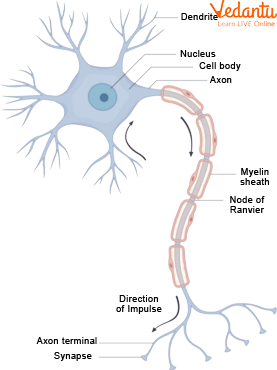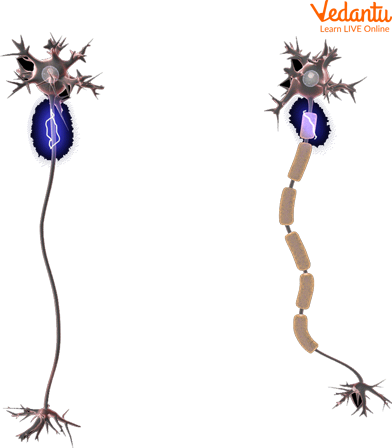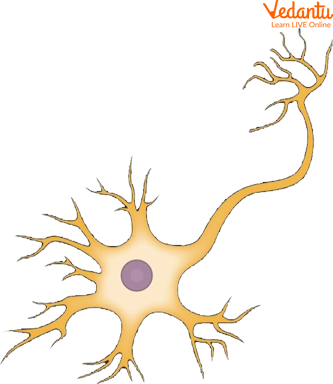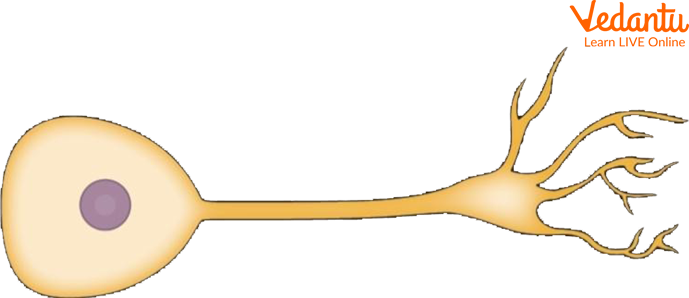




An Overview of Different Functions of Neurons
Have you ever wondered how you move your hands away from any stimulus that can be potentially harmful to you suddenly without any conscious effort? The answer is with the help of your nerves and nervous system. Your nervous system is carrying out a multitude of functions with the highest precision and accuracy and efficiency. The nervous system is the system that controls signalling, actions and reactions from the brain to all the body parts and vice versa. Now the question arises is what are neurons? Let’s dive in and see in the detail What are neurons, its structure, neuron diagram, types and Nerve cell functions

Structure of a Nerve Cell
Structure of Nerve Cell
The fundamental unit of an organism's nervous system is a nerve cell or neuron. The neurons are those specialized cells that can transmit electrical or chemical signals throughout the body. As can be seen in the above neuron diagram, the neuron comprises various parts. The structure of nerve cells or neurons varies depending upon the functions it performs and the location of their presence. Now the question arises: What function do nerve cells perform? The functioning of the nervous system is vital for the control, coordination, and balance of one's body. The smallest unit, i.e. nerve cells or neurons, all work together in a coordinated manner to carry out the above functions.
Parts of Nerve Cells
A nerve cell comprises the following parts - a cell body, dendrites, and axon.
Cell Body
The cell body has a nucleus, endoplasmic reticulum, Golgi bodies, and some granular bodies called Nissl's granules.
Dendrites
Dendrites are branching units growing out of the cell body, which usually transmit and take an impulse from the target organ/cell/tissue.
Axon
Axon is the tubular structure that carries the impulse and passes it on to the next neuron.
Axons are of Two Types:
Myelinated - are the axons enveloped by Schwann cells which form a myelin sheath around the axon. The gap between two consecutive myelin sheaths is known as the nodes of Ranvier.
Non-Myelinated - are the axons that don't possess Schwann cells and do not have myelin sheath around them.

Myelinated and Unmyelinated Axons
Types of Neurons
There are different types of neurons classified based on locations of conduction and transmission point of the stimulus:
Sensory Neurons
These neurons carry signals from the external environment and relay them to the brain and the spinal cord.
Motor Neurons
These are the most common neurons that relay information from the brain to the body's muscles.
Interneurons
These neurons connect the motor and sensory nerves and help to signal between nearby neurons.
Classification of Neurons Based on the Number of Dendrites and Axons
Neurons on the bases of axons and dendrites are further classified into three types:
Multipolar - These neurons have a single axon and two or more dendrites.

Multipolar Neuron
Bipolar - These neurons have a single axon and single dendrite: for example - the retina of the eye.

Bipolar Neuron
Unipolar - These neurons only consist of the cell body, and a single axon is usually present during embryonic stages.

Unipolar Neuron
Master Coordinator of Human Body
For humans to function, every organ in each body system must cooperate with every other organ in that system and with every other body system. Each biological system is coordinated by the nervous system both inside that system and with other systems. The neurological system regulates all actions and sensations as well as all thoughts, feelings, and memories. The nervous system monitors changes or stimuli, stores information, and/or triggers response impulses throughout impacted bodily systems for action and sensation, emotion, thought, and memory since situations inside and outside the body are always changing.
Summary
The functioning of neurons is more unique than any other cell in our body. They are self-excited, making them more adapted to have a specialized role in the conduction and transmission of impulses, to and from the target organ. The neurons, thus, form the structurally essential practical unit of the sensory system sending and getting impulses to and from different parts of the body to the nervous or sensory system. This article was all about what function does a nerve cell perform, the function of neurons, what are neurons and the structure of nerve cell.
FAQs on What Function So Nerve Cells Perform?
1. What is a reflex action?
Reflex action is an inborn capability of human survival instincts that helps them move away from danger without any conscious effort. It is an automatic, quick reaction to a stimulus that helps to protect the body from potentially dangerous situations like touching something hot or too cold or something poisonous. Examples:
The pupil of the eye changes size in response to a stimulus from light.
When a pin pricks you, your hand or leg may suddenly and jerkily withdraw.
2. What are the parts of which the nervous system is made?
The nervous system is made up of three major parts which include the brain, spinal cord, and nerves. The brain is the master controller of the whole body and regulates various functions like feelings, thoughts, respiration and other related bodily functions. The brain, spinal cord and a massive network of nerves extend throughout the entire body to make up the nervous system.
3. Do nerves have memory?
It has long been known that the central nervous system "remembers" painful experiences, that they leave a memory trace of pain. And when there is new sensory input, the pain and memory in the brain magnify the feeling so that even a gentle touch can be excruciating.
4. What forms the basic connections between the nerve cells?
The brain forms the major basic connections between the neurons that are present throughout our body.









